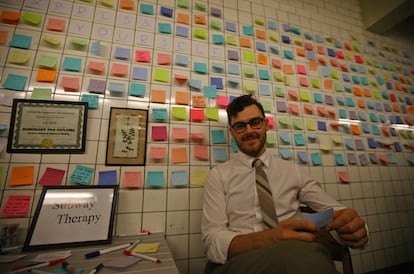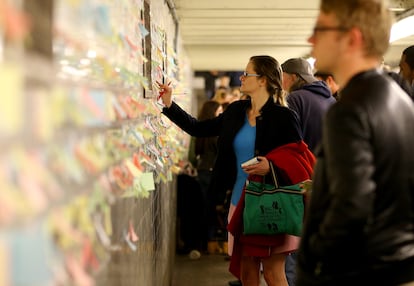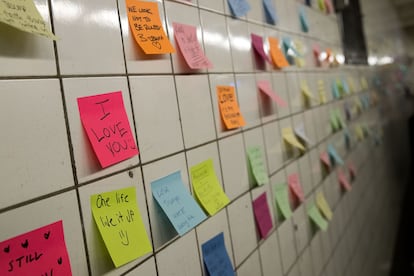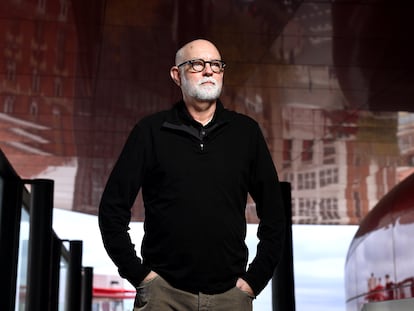Matthew ‘Levee’ Chavez, the creator of free therapy on the New York subway
The young artist, who has launched several projects in the city’s train stations, has won several awards for his initiative ’Subway Therapy’


At the 14th Street and Sixth Avenue subway station in New York, there is a tunnel full of colorful post-its with messages written by different people. New Yorkers stop to write down what they are thinking at that moment and share it publicly but anonymously, channeling much of the emotions of the presidential election. “Oh my god, why Trump?” “Be kind” or “Freedom” read some of the messages.
The initiative has been going on since 2016, but has never lost relevance: it is Subway Therapy (@subwaytherapy on Instagram), a project created by Matthew “Levee” Chavez, who has already won two awards, receiving the Municipal Art Society’s Brendan Gill Prize and the Demos Transforming America Award in 2017.
Question: Is it easy to develop an artistic project of this type in the New York subway?
Answer. No, not at all. People can sometimes be violent: there have been times when they have torn up post-its, kicked the table and chair to write them, they shout, they get angry… But still, I love the subway. I love making art where it is least expected. My purpose is to bring art outside of museums and galleries, to where the people are.
Q. How did Subway Therapy come about?
A. It was the evolution of another project. When I moved to New York in the Christmas of 2015, I told my mother that I wanted to ask people about their secrets; I wanted to help them feel good about something they felt bad about. That was the beginning of New York Secret Keeper. For a few months, I spent my time listening to people’s secrets on the New York subway.
Q. People are always in a hurry on the subway, did they really stop to tell you their secrets?
A. All the time! I used to spend about four hours a day on the subway, and I got to the point, where I was talking to about 30 people a day.

Q. And what kind of secrets did they tell? Stories of betrayal? Murder?
A. Mostly funny stuff. For example: ‘My best friend saved $5,000 in my bank account and I spent it.’ You can see the stories on the project account, @newyorksecretkeeper. It was going really well, it was even going to be part of a group exhibition at the Smithsonian, but Covid put an end to it. Along the same lines, I created The Secret Phone, which is an installation made up of a phone, which people can use to tell a secret in order to feel the relief of confession, of sharing it. So far I have collected 590 secrets. Someone told me that they were doing therapy and from that idea came Subway Therapy.
Q. Have you got into any trouble for your artistic projects in the subway?
A. I’ve been doing this for many years, they know me, and I have a good relationship with the Metropolitan Transportation Authority (MTA), although we haven’t made any official arrangements. However, my displays are not permanent. I usually pick up the post-its around 8 p.m. and put them back in the same place or a different one around 2 p.m. Even so, I have been kicked out a few times. For example, not long ago I was kicked out of the Columbus Circle station.
Q. What do you hope to achieve with these projects?
A. Finding ways to connect, unite and dignify people. The ultimate satisfaction is watching two strangers start talking, and it’s especially gratifying because we’re facing a terrible division in America.
Q. Your projects resonate a lot with Humans of New York and The Strangers Project, do you know their creators?
A. Yes, I actually have a good anecdote. Brandon, the director of The Strangers Project, has been my roommate for six months.

Q. These projects are mainly altruistic. How do you manage to get by in a city like New York?
A. Sometimes there are opportunities to make money, through exhibitions, partnerships with other organizations, or publishing books. I have published two so far: Art in Action and Signs of Hope. But aside from that, I now work as an event producer for a non-profit organization, Idealist.org, which is aligned with my values. They are dedicated to encouraging people to do something for their community, to creating a better world, to finding a path between intention and action. For example, yesterday we spent the day handing out flowers to people, and it was beautiful.
Q. What are your upcoming projects?
A. My next project is called What is America Tour. Taking advantage of the 250th anniversary of America, I’m going to travel to parts of the America where understanding is often elusive — places like Florida, Ohio, Arizona, and the Deep South. The idea is to set up a table with two chairs and sit down to have conversations with people, to try to understand both versions and find a common path to create some unity.
Q. Your last name is Chavez, what are your roots?
A. My great-grandfather was Spanish and married an Indigenous woman in New Mexico. I was born in the United States, but I am one-quarter Italian, one-quarter Czech, one-quarter Mexican and one-quarter Spanish: the classic American mix.
Sign up for our weekly newsletter to get more English-language news coverage from EL PAÍS USA Edition
Tu suscripción se está usando en otro dispositivo
¿Quieres añadir otro usuario a tu suscripción?
Si continúas leyendo en este dispositivo, no se podrá leer en el otro.
FlechaTu suscripción se está usando en otro dispositivo y solo puedes acceder a EL PAÍS desde un dispositivo a la vez.
Si quieres compartir tu cuenta, cambia tu suscripción a la modalidad Premium, así podrás añadir otro usuario. Cada uno accederá con su propia cuenta de email, lo que os permitirá personalizar vuestra experiencia en EL PAÍS.
¿Tienes una suscripción de empresa? Accede aquí para contratar más cuentas.
En el caso de no saber quién está usando tu cuenta, te recomendamos cambiar tu contraseña aquí.
Si decides continuar compartiendo tu cuenta, este mensaje se mostrará en tu dispositivo y en el de la otra persona que está usando tu cuenta de forma indefinida, afectando a tu experiencia de lectura. Puedes consultar aquí los términos y condiciones de la suscripción digital.
More information
Archived In
Últimas noticias
Rowan Atkinson tops Netflix at 70: ‘He’s as funny as ever’
Israeli recognition of Somaliland stirs up the Gulf
Tiger Woods turns 50: Will he continue playing on the PGA Tour or take a back seat?
The surreal journey of James Nnaji, the Barcelona youth player selected in the NBA Draft who ended up in the NCAA
Most viewed
- Oona Chaplin: ‘I told James Cameron that I was living in a treehouse and starting a permaculture project with a friend’
- Reinhard Genzel, Nobel laureate in physics: ‘One-minute videos will never give you the truth’
- Sinaloa Cartel war is taking its toll on Los Chapitos
- Why the price of coffee has skyrocketed: from Brazilian plantations to specialty coffee houses
- Chevy Chase, the beloved comedian who was a monster off camera: ‘Not everyone hated him, just the people who’ve worked with him’










































